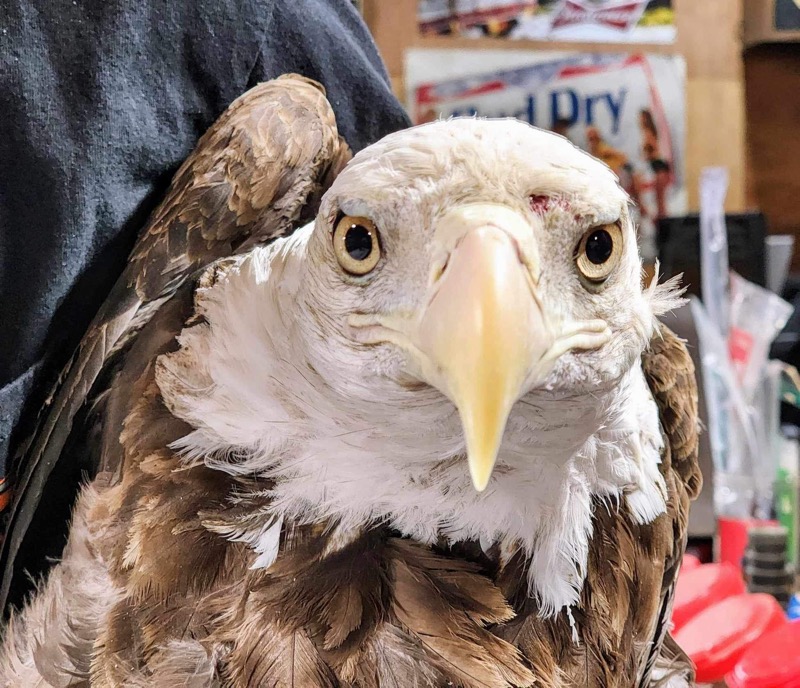***Images below may be disturbing to some viewers***
The wife-and-husband team, Tammy and Jim Yarger, give their time and money to rescue and rehab wildlife in Central Illinois. They have already rescued six bald eagles with lead poisoning this year. Miss Liberty is one of the eagles that survived lead poisoning, but she suffers from significant neurological defects that prevent her from ever being released back into the wild. Miss Liberty is unable to fly very far and eat on her own; she must be hand-fed. Hog Capitol Wildlife Rescue and Rehab always need donations for chelation pills and neurological medications for Bald Eagles that have lead poisoning.
I had the opportunity to assist Tammy and Jim Yarger as they performed their intake process for two Bald Eagles they rescued on Saturday, March 16, 2024. One of the eagles had lead poisoning, and the other had a significant facial injury. The eagle with the critical facial injury was likely struck by lightning during the storm the night before he was found. Watch the video below of the hour-long process to remove the necrotic tissue and discover the gravity of his injuries. Beautiful Girl (BG) had a lead level of 9.5 at intake. Thanks to chelation therapy, her lead level is now too low to detect. She will continue chelation therapy and be retested in a few days. The Bald Eagles can rebound to a high lead level in a short time. Watch the video below of BG during the intake process; she chatters a lot.
Chelation therapy is $300 a week per bird. There is no standard timeframe for chelation therapy, each bird is different. They may need the chelation therapy for a week or months. The cost of a bottle of liquid chelation suddenly increased to around $5,000. Due to the incredible cost of a bottle, the Yargers must purchase the chelation in pill form. The Kewanee Vet Clinic purchases the chelation from OSF St. Francis and then sells it to Hog Capitol Wildlife Rescue and Rehab. As you will see in the video below, it is much more difficult to administer the pill form to the eagles compared to the liquid form.
Bald Eagles get lead poisoning from bullets and fishing lures that contain lead. You can help our nation’s birds by using ammunition and fishing lures that do NOT contain lead. If you use standard ammunition, do not leave the intestines on the ground after you field-dress the animal. Take them with you or bury them so bald eagles do not consume bullet fragments in the field dress. Bald Eagles also eat fish and may also consume lead from fishing lures containing lead. Bald Eagles are opportunistic eaters and will consume food that is available in their hunting area.
Here are ways you can donate and help Tammy and Jim Yarger save wildlife:
Paypal Link: here
Venmo Link: here
Mail to: Tamara Yarger, 824 N Burr Blvd, Kewanee, IL 61443
Donate to the Kewanee Vet Clinic for Hog Capitol Account: 206 Townsedge Road, Kewanee, IL 61443, or call 309-852-2252.
Hog Capitol Wildlife Rescue and Rehab rescues all wildlife. They currently have a baby bunny, that will be released soon and a three-week-old red fox. The baby fox will go home to her mom in Geneseo if the den is found; otherwise, she will go to privately owned timbers with other foxes. Watch the videos below of the baby red fox.
According to ‘Demographic implications of lead poisoning for eagles across North America’ published on Science.org, Lead poisoning occurs worldwide in populations of predatory birds, but exposure rates and population impacts are known only from regional studies. We evaluated the lead exposure of 1210 bald and golden eagles from 38 US states across North America, including 620 live eagles. We detected unexpectedly high frequencies of lead poisoning of eagles, both chronic (46 to 47% of bald and golden eagles, as measured in bone) and acute (27 to 33% of bald eagles and 7 to 35% of golden eagles, as measured in liver, blood, and feathers). Frequency of lead poisoning was influenced by age and, for bald eagles, by region and season. Continent-wide demographic modeling suggests that poisoning at this level suppresses population growth rates for bald eagles by 3.8% (95% confidence interval: 2.5%, 5.4%) and for golden eagles by 0.8% (0.7%, 0.9%). Lead poisoning is an underappreciated but important constraint on continent-wide populations of these iconic protected species.”
“Studies have shown lethal effects to individual birds, but this new study is the first to show population-level consequences from lead poisoning to these majestic species at such a wide scale,” said Anne Kinsinger, USGS Associate Director for Ecosystems. “This is the first study of lead poisoning of wildlife at a nationwide scale, and it demonstrates the unseen challenges facing these birds of prey. We now know more about how lead in our environment is negatively impacting North America’s eagles,” said Todd Katzner, USGS wildlife biologist and lead USGS author. Read more from the USGS here.
This bald eagle had a lead level too high to register. Watch here. He passed away on February 10, 2024, from lead poisoning.
Another Bald Eagle with lead poisoning was rescued today, March 22, 2024. Watch the video here. He is gasping for air with an airway obstruction and a high lead level. He passed away early Sunday morning.
This bald eagle was rescued from Iowa on Saturday. She passed away on Sunday from rodenticide and lead poisoning. Her blood was too thick to even test for lead poisoning because of the pesticide. She suffered frequent seizures while she was in the care of Hog Capitol Wildlife Rescue and Rehab.
Here are ways you can donate and help Tammy and Jim Yarger save wildlife:
Paypal Link: here
Venmo Link: here
Mail to: Tamara Yarger, 824 N Burr Blvd, Kewanee, IL 61443
Donate to the Kewanee Vet Clinic for Hog Capitol Account: 206 Townsedge Road, Kewanee, IL 61443, or call 309-852-2252.










